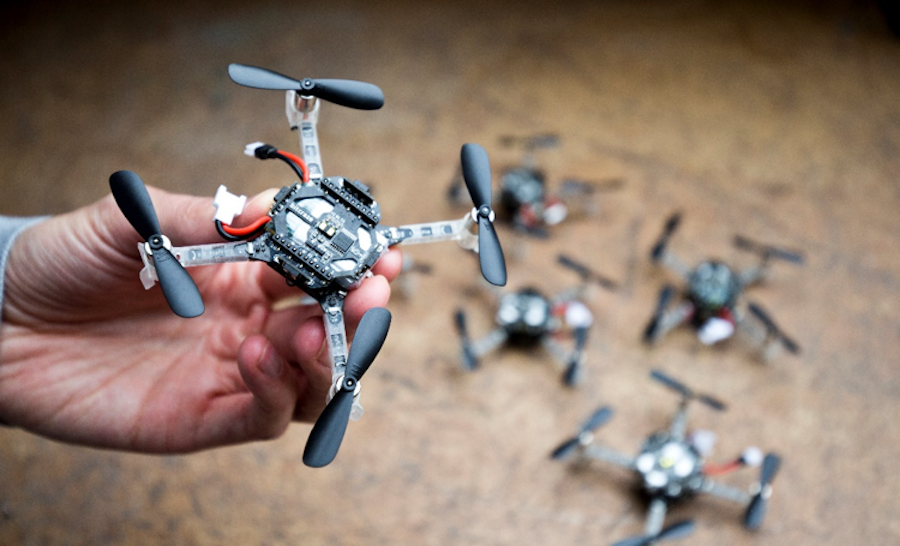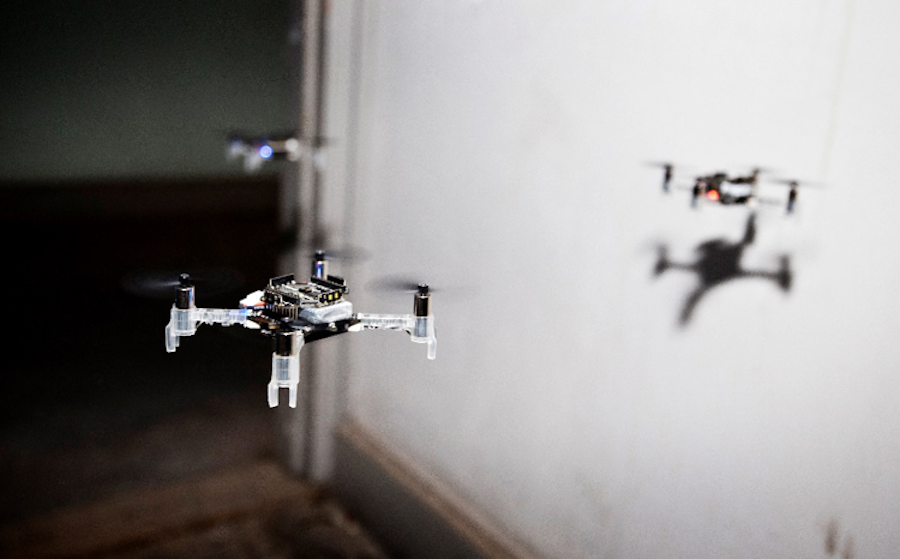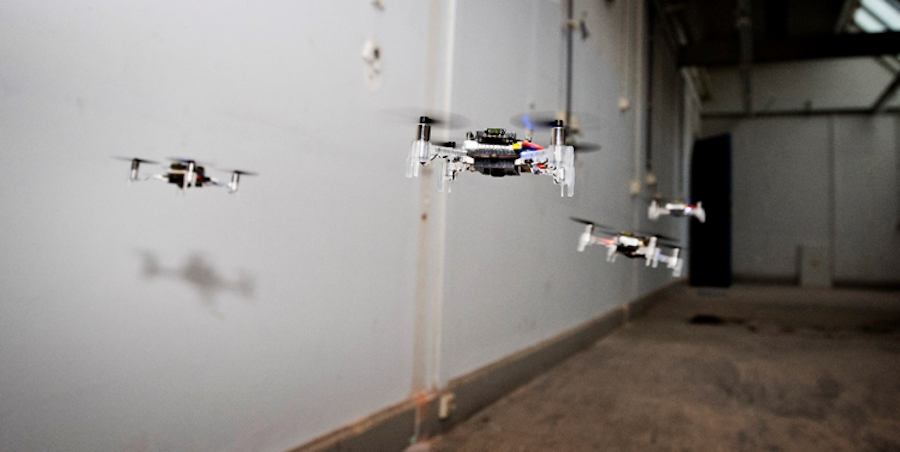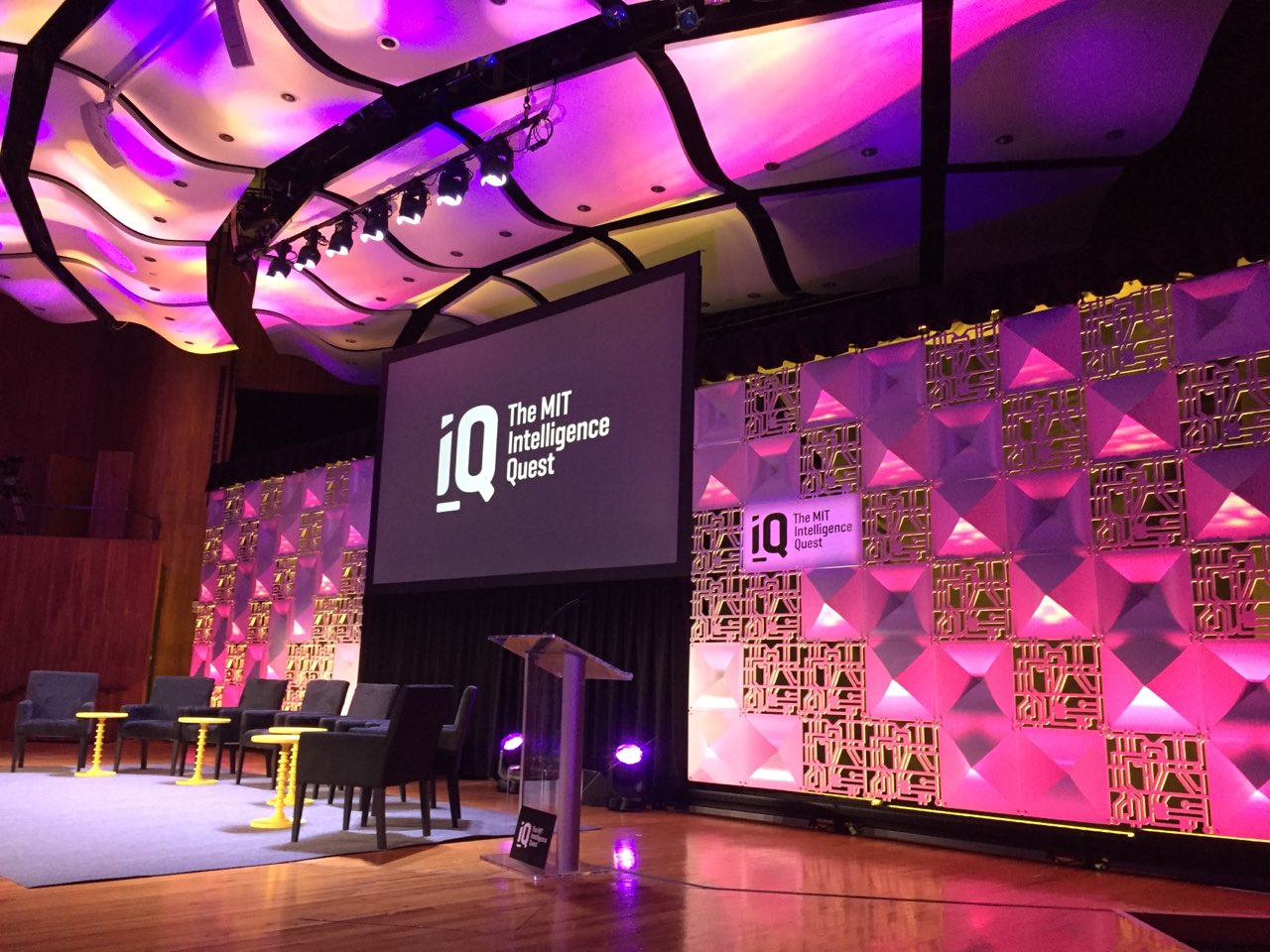Rebel Robot Helps Researchers Understand Human-machine Cooperation
A swarm of autonomous tiny flying robots
By K.N. McGuire, C. De Wagter, K. Tuyls, H.J. Kappen, G.C.H.E. de Croon
Greenhouses, search-and-rescue teams and warehouses are all looking for new methods to enable surveillance in a manner that is quick and safe for the objects and people surrounding them. Many of them already found their way into robotics, but wheeled ground-bound systems have limited maneuverability. Ideally it would be great if flying robots, a.k.a. micro aerial vehicles (MAV) can take advantage of their 3rd dimension to perform surveillance. A group or a swarm of them should be ideal to cover as much ground as possible. The price of fully autonomous MAVs usually comes with the cost of weight and size. This is problematic in green- and warehouses in particular, as many of us would not be comfortable working with 3 kilo MAVs flying over our heads.

There have been many advances already in artificial intelligence and navigation techniques to make MAVs fully autonomous navigators through these unknown areas. However, these techniques are computationally expensive and therefore need substantial on-board calculating power. A smaller MAV could rely on the aid of an external computer, but this will become a problem as soon as their numbers and the environment increase in size. Communication speeds through the inner structure of a building will degrade quickly, which makes any search-and-rescue scenario ill-fated. Ideally, a group of tiny MAVs would need to be independent and only use their onboard sensing and computing capabilities. Imagine making such tiny drones navigate in a GPS-deprived environment without the help of an external positioning system.
At the MAVLab of the TU Delft, we have tried to tackle this difficult problem by thinking of creative ways to solve the difficult issues surrounding autonomous indoor navigation. We try to look at nature for inspiration and have implemented that successfully in the past with the Delfly or optical flow-based control. So, if a swarm of bees can do it, why not a group of tiny MAVs? That did not turn out as easy as it initially seemed, as we needed to solve the intermediate issues out from the ground up. An individual bee is very talented as it can already avoid trees, bushes and his peers as soon as it has a chance to spread its wings. These capabilities do not come naturally to an MAV, and this has to be implemented in a very robust manner, because a crashed MAV usually cannot recover by itself. A bee can already go out and explore a field of flowers, and return to its home hive once it’s done. This is something that an MAV weighing less then 50 grams has never done autonomously before, let alone a swarm.

Since many navigation strategies are out of the question because of their complexity, we had to turn to other inspiration from the insect kingdom, namely a path planning technique called ‘Bug Algorithms’. Although the name suggests otherwise, bug algorithms are not really inspired by biology. These algorithms originated for mathematical path planning techniques, of which the core principles are that they require very little memory and are very simple in computation. The idea revolves around the fact that an agent has to go from A to B, and will deal with the intermediate obstacles on-the-fly by following their border (a.k.a. wall-following). Once the path towards the goal is clear, the agent will resume its way towards to goal again. By remembering some places along the way, it can make different decisions on locations it has encountered again to make sure it does not get stuck in an endless loop. By a set of very simple rules and memory blocks which only take a fraction of the computing power and memory, an agent can in most cases find its way to its goal. However, the main problem of most existing bug algorithms is that they rely on a known global location (as with GPS) or rely on perfect odometry. Hence, most existing bug algorithms are actually not so well suited for application to tiny robots that navigate in the real world.

We developed our own bug algorithm and extended it to make it suitable for a swarm of MAVs navigating in the real world. The swarm is leveraged by having the MAVs travel in different directions. The MAVs first fly away from the base station, exploring their environment. They are able to come back with the help of a wireless beacon located at the base station. Based on the signal strength of their connection with the beacon, they can evaluate the right direction to go back to. The MAVs are also communicating with each other for sharing their exploration preference and to avoid each other. We called this technique the Swarm Gradient Bug Algorithm (SGBA).
On the Faculty of Aerospace engineering of the Delft University of Technology, on the 11th floor of the highrise building, we used an empty office space for an ultimate system test of SGBA. We acquired 6 off-the-shelf MAVs, namely the Crazyflie 2.0’s of Bitcraze AB, equipped with the Flowdeck and Multirangerdeck. Six of these are sent in different directions to cover as much ground as possible in the beginning, while they were coordinating and avoiding each other at the same time. Once their battery is at 60%, they navigate back to the home beacon. With this, the crazyflies explored 80 % of the open rooms, and on average 4 of the 6 were able to return out of the 5 flights performed. Next to this, we have also experimented with configurations with 2 and 4 crazyflies, which resulted in 15 test flights in the real-world environment, backed up with hundreds of simulated environment flights with greater quantities.
Although we are very happy with the autonomous exploration by our swarm of MAVs, we see ample space for improvement, ranging from more robust obstacle detection and avoidance to more accurate intra-swarm distance sensing. On the long run, we envisage also vision-based navigation for small MAVs without a beacon at the base station. Still, for the time being, the proposed navigation method is already suitable for practical swarm navigation of small robots, as a single beacon at the base station is not a very limiting factor. Moreover, we hope that the main concept behind SGBA – trading off the accuracy of highly detailed navigation maps against substantially less computational requirements – will inspire others to tackle similarly complex missions with swarms of tiny robots.
For details on the experiments and SGBA, please check the paper:
Minimal navigation solution for a swarm of tiny flying robots to explore an unknown environment K.N. McGuire, C. De Wagter, K. Tuyls, H.J. Kappen, G.C.H.E. de Croon
Science Robotics, 23 October
#IROS2019 live coverage and IROS TV

The 2019 IEEE/RSJ International Conference on Intelligent Robots and Systems (#IROS2019) is being held in Macau this week. The theme this year is “robots connecting people”.
The conference accepted 1,127 papers for oral presentation, 148 late breaking news posters, and 41 workshops and tutorials.
For those who can’t make it in person, or can’t possibly see everything, IROS is launching IROS TV, an onsite conference television channel featuring a new episode daily that is screened around the conference venue and online.
The TV shows profile the research of scientists, educators, and practitioners in robotics, and provide an opportunity to learn about advances in robotics.
You can also follow #IROS2019 or @IROS2019MACAU on twitter.
Sabine (@sabinehauert) from Robohub will be on site, please share your IROS stories, and latest publications with her.
Sewbots Transforming The Textile Industry
The Human Touch
Making the Move to Mobile
Transience, Replication, and the Paradox of Social Robotics

with Guy Hoffman
Robotics Researcher, Cornell University
An Art, Technology, and Culture Colloquium, co-sponsored by the Center for New Music and Audio Technologies and CITRIS People and Robots (CPAR), presented with Berkeley Arts + Design as part of Arts + Design Mondays.
As we continue to develop social robots designed for connectedness, we struggle with paradoxes related to authenticity, transience, and replication. In this talk, I will attempt to link together 15 years of experience designing social robots with 100-year-old texts on transience, replication, and the fear of dying. Can there be meaningful relationships with robots who do not suffer natural decay? What would our families look like if we all choose to buy identical robotic family members? Could hand-crafted robotics offer a relief from the mass-replication of the robot’s physical body and thus also from the mass-customization of social experiences?
About Guy Hoffman
Dr. Guy Hoffman is an Assistant Professor and the Mills Family Faculty Fellow in the Sibley School of Mechanical and Aerospace Engineering at Cornell University. Prior to that he was an Assistant Professor at IDC Herzliya and co-director of the IDC Media Innovation Lab. Hoffman holds a Ph.D from MIT in the field of human-robot interaction. He heads the Human-Robot Collaboration and Companionship (HRC2) group, studying the algorithms, interaction schema, and designs enabling close interactions between people and personal robots in the workplace and at home. Among others, Hoffman developed the world’s first human-robot joint theater performance, and the first real-time improvising human-robot Jazz duet. His research papers won several top academic awards, including Best Paper awards at robotics conferences in 2004, 2006, 2008, 2010, 2013, 2015, 2018, and 2019. His TEDx talk is one of the most viewed online talks on robotics, watched more than 3 million times.
About the Art, Technology, and Culture Colloquium
Founded by Prof. Ken Goldberg in 1997, the ATC lecture series is an internationally respected forum for creative ideas. Always free of charge and open to the public, the series is coordinated by the Berkeley Center for New Media and has presented over 200 leading artists, writers, and critical thinkers who question assumptions and push boundaries at the forefront of art, technology, and culture including: Vito Acconci, Laurie Anderson, Sophie Calle, Bruno Latour, Maya Lin, Doug Aitken, Pierre Huyghe, Miranda July, Billy Kluver, David Byrne, Gary Hill, and Charles Ray.
Fall 2019 – Spring 2020 Series Theme: Robo-Exoticism
In 1920, Karl Capek coined the term “robot” in a play about mechanical workers organizing a rebellion to defeat their human overlords. A century later, increasing popularism, inequality, and xenophobia require us to reconsider our assumptions about labor, trade, political stability, and community. At the same time, advances in artificial intelligence and robotics, fueled by corporations and venture capital, challenge our assumptions about the distinctions between humans and machines. To explore potential linkages between these trends, “Robo-Exoticism” characterizes a range of human responses to AI and robots that exaggerate both their negative and positive attributes and reinforce fears, fantasies, and stereotypes.
Robo-Exoticism Calendar
09/09/19 Robots Are Creatures, Not Things
Madeline Gannon, Artist / Roboticist, Pittsburgh, PA
Co-sponsored by the Jacobs Institute for Design Innovation and CITRIS People and Robots (CPAR)
09/23/19 The Copper in my Cooch and Other Technologies
Marisa Morán Jahn, Artist, Cambridge, MA and New York, NY
Co-sponsored by the Wiesenfeld Visiting Artist Lecture Series and the Jacobs Institute for Design Innovation
10/21/19 Non-Human Art
Leonel Moura, Artist, Lisbon
Co-sponsored by the Department of Spanish & Portuguese and CITRIS People and Robots (CPAR)
11/4/19 Transience, Replication, and the Paradox of Social Robotics
Guy Hoffman, Robotics Researcher, Cornell University
Co-sponsored by the Center for New Music and Audio Technologies and CITRIS People and Robots (CPAR)
01/27/20 Dancing with Robots: Expressivity in Natural and Artificial Systems
Amy LaViers, Robotics, Automation, and Dance (RAD) Lab
Co-sponsored by the Department of Theater, Dance, and Performance Studies and CITRIS People and Robots (CPAR)
02/24/20 In Search for My Robot: Emergent Media, Racialized Gender, and Creativity
Margaret Rhee, Assistant Professor, SUNY Buffalo; Visiting Scholar, NYU
Co-sponsored by the Department of Ethnic Studies and the Department of Comparative Literature
03/30/20 The Right to Be Creative
Margarita Kuleva, National Research University Higher School of Economics, Moscow
Invisible Russia: Participatory Cultures, Their Practices and Values
Natalia Samutina, National Research University Higher School of Economics, Moscow
Co-sponsored by the Department of Slavic Languages and Literature and Department of the History of Art and the Arts Research Center
04/06/20 Artist Talk
William Pope.L, Artist
Presented by the Department of Art Practice
04/13/20 Teaching Machines to Draw
Tom White, New Zealand
Co-sponsored by Autolab and CITRIS People and Robots (CPAR)
For more information:
Contact: info.bcnm [at] berkeley.edu, 510-495-3505
ATC Director: Ken Goldberg
BCNM Director: Nicholas de Monchaux
Arts + Design Director: Shannon Jackson
BCNM Liaisons: Lara Wolfe, Laurie Macfee
ATC Highlight Video from F10-S11 Season (2 mins)
http://j.mp/atc-highlights-hd
ATC Audio-Video Archive on Brewster Kahle’s Internet Archive:
http://tinyurl.com/atc-internet-archive
ATC on Facebook:
https://www.facebook.com/cal-atc
ATC on Twitter:
https://www.twitter.com/cal_atc
BionicOpter is the biggest flying robotic insect – Festo in Guinness World Records 2020
US Digital Automates Production Process Using Robot and In-House Engineering Talent
#296: Robust Robotics and the Quest for Intelligence, with Nicholas Roy

In this episode Lilly Clark interviews Nicholas Roy, Professor of Aeronautics and Astronautics at MIT, about the Quest for Intelligence initiative and his research in robust robotics. Roy discusses how cognitive science pushes artificial intelligence, further pushing the capabilities of engineering tools and services, and speaks about the importance of explainable and ethical AI. He explains the challenges of capturing context and semantics in useful models of a system, and designing unmanned aerial vehicles and robots which interact with humans.
Nicholas Roy

Nicholas Roy is the Bisplinghoff Professor of Aeronautics and Astronautics at MIT, and leads the Robust Robotics Group in the Computer Science and Artificial Intelligence Laboratory. He received a BS and MS from McGill University, and a PhD from Carnegie Mellon University. His research interests span robotics, machine learning, planning and reasoning, and human-computer interaction.
Links